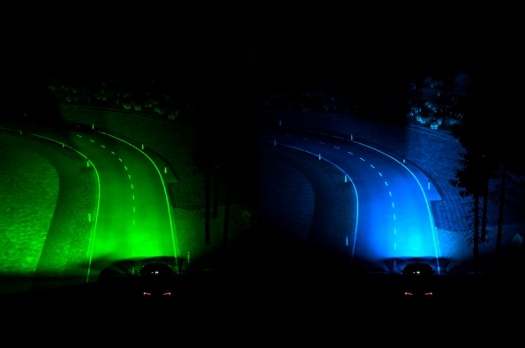 |
| May 04, 2021 | Volume 17 Issue 17 |
Designfax weekly eMagazine
Archives
Partners
Manufacturing Center
Product Spotlight
Modern Applications News
Metalworking Ideas For
Today's Job Shops
Tooling and Production
Strategies for large
metalworking plants
New Ford predictive headlights aim to use GPS and more

Ford's predictive headlights (left) show drivers where to go more quickly and safely when approaching corners.
Driving at night, especially on winding and unfamiliar roads, may become a less stressful experience if Ford's new predictive headlights are perfected.
The company first pioneered using road signs and lane markings as cues to adjust headlight beams to better illuminate the road ahead, especially around intersections.
Now, engineers from Ford Research and Advanced Engineering Europe are testing technology that uses real-time location data to show the car the way to go. The predictive smart headlight system directs beams into upcoming corners -- even before drivers may see them -- illuminating hazards, vehicles, and pedestrians more quickly and effectively.
The prototype advanced lighting system uses GPS location data, advanced technologies, and highly accurate street geometry information to identify turns in the road ahead. An algorithm calculates the trajectory and speed of the vehicle to adjust the direction of its headlights proactively, providing optimal light coverage of bends, intersections, and even hazards lurking around the corner.
If the vehicle encounters a stretch of road where location data is not available, the system will work alongside camera- and steering-based dynamic headlight-bending technologies to continue to light the road until the location data improves.
"The predictive lighting technology we are developing now means that one day driving in the dark could be as simple as just following your headlights," said Michael Koherr, Ford European lighting research engineer. "This new map- and location-based system is the next step on our quest to make driving at night no more difficult or stressful as during the day."
Ford researchers have made extensive use of "digital twin" simulation that recreates the physical world in a virtual environment for this project. The simulator accurately calculates how light falls and reflects in the real world, enabling researchers to better visualize and optimize the technology for drivers.
Ford did not give a target date for project completion, but it all sounds promising.
Source: Ford Motor Co.
Published May 2021
Rate this article
View our terms of use and privacy policy
